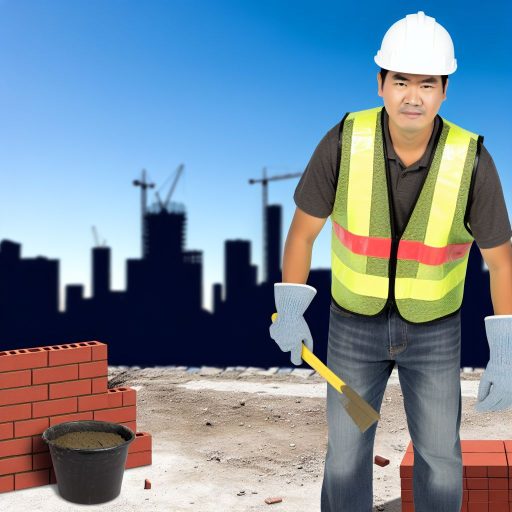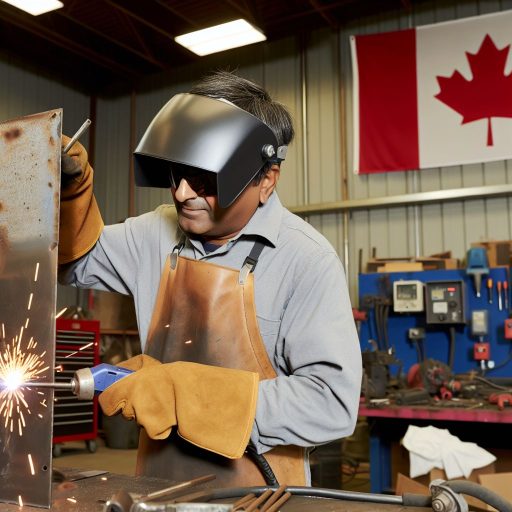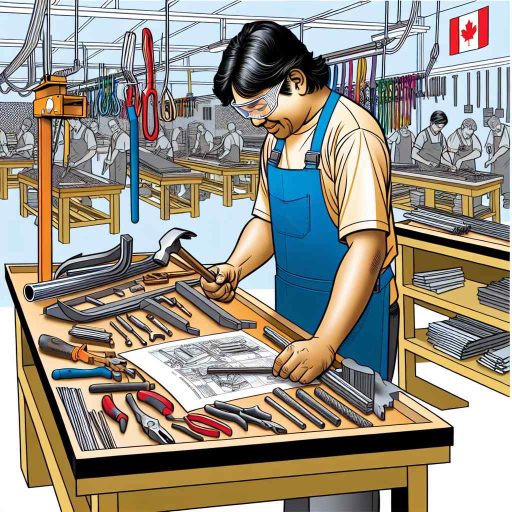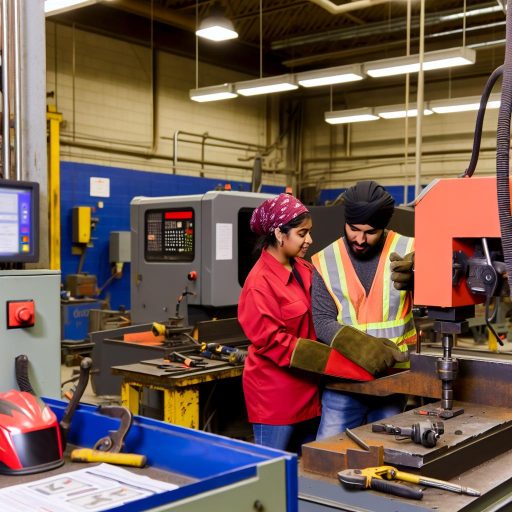Overview of Ironworker Profession and Its Importance in Construction
The ironworker profession is vital to the construction industry.
Ironworkers install iron and steel into buildings and other structures.
They shape the very frame that supports our cities.
Working at height, ironworkers face unique safety challenges.
Thus, they must adhere to strict safety protocols daily.
These professionals are skilled in reading blueprints and technical drawings.
Understanding these plans ensures accurate installation of materials.
Moreover, ironworkers often collaborate with other tradesmen.
This teamwork is essential for completing projects efficiently.
Ironworkers commonly work on diverse projects.
These include bridges, skyscrapers, and industrial facilities.
The profession requires physical strength and stamina.
Additionally, they need mechanical skills to handle equipment.
This combination of skills contributes to the overall project success.
Ironworkers also play a key role in ensuring structural integrity.
They help create safe environments for countless individuals.
Furthermore, continuing education is crucial for ironworkers.
It helps them stay updated on new techniques and safety practices.
The ironworker profession significantly impacts the construction landscape.
Without their expertise, modern structures would not be possible.
Daily Routine of an Ironworker: A Breakdown of Tasks
Starting the Day
The day begins early for ironworkers at 6:00 AM.
They congregate at the job site for safety briefings.
During these meetings, supervisors discuss the day’s objectives.
Ironworkers review blueprints and plans before starting their tasks.
Preparing Tools and Materials
After initial discussions, ironworkers gather their tools.
Unlock Your Career Potential
Visualize a clear path to success with our tailored Career Consulting service. Personalized insights in just 1-3 days.
Get StartedThey ensure every piece of equipment is in good condition.
Next, they review the materials needed for the day’s tasks.
The team checks for the availability of steel beams and reinforcements.
Primary Tasks of the Day
Ironworkers primarily focus on structural steel installation.
They lift and place heavy steel beams into position.
This requires precise coordination and communication among teams.
Next, they secure beams using bolts and welding techniques.
Safety Practices
Throughout the day, safety is a continuous priority.
Ironworkers wear personal protective equipment at all times.
They follow protocols to minimize risks on the job site.
Regular safety checks ensure a secure work environment.
Midday Break
After several hours of work, a lunch break is taken.
This time provides an opportunity for relaxation and hydration.
Ironworkers often share meals and discuss the progress made.
Afternoon Tasks
The afternoon resumes with tasks like reinforcing structures.
Ironworkers may adjust or replace beams as necessary.
They continually assess the integrity of the structures being built.
Ending the Day
The workday concludes around 4:00 PM.
Ironworkers clean their tools and secure the job site.
They participate in a debriefing to address any issues faced.
Finally, they review the accomplishments before heading home.
Safety Protocols and Equipment Used by Ironworkers
Importance of Safety Protocols
Safety protocols protect ironworkers from potential hazards on the job site.
These protocols are essential for maintaining a safe working environment.
Moreover, adhering to safety guidelines reduces the risk of accidents.
Common Safety Equipment
Personal Protective Equipment (PPE) is vital for ironworkers.
Standard PPE includes hard hats, safety glasses, and gloves.
Additionally, high-visibility vests improve worker visibility in busy areas.
Steel-toed boots provide necessary foot protection against heavy materials.
Fall Protection Systems
Fall protection is crucial when working at heights.
Ironworkers commonly use harnesses and lanyards for fall safety.
Guardrails are also installed to provide an additional layer of protection.
Furthermore, safety nets can help catch falls and prevent injuries.
Handling Heavy Materials
Ironworkers often use cranes for lifting heavy steel components.
Proper rigging techniques ensure secure loads during transportation.
Additionally, team communication is vital to coordinate lifting activities.
Training and Compliance
Regular training sessions promote safety awareness among ironworkers.
Workers must stay informed about the latest safety regulations.
Compliance with OSHA standards ensures a safer workplace for all.
Explore Further: Key Tools Used by Professional Metal Fabricators
Types of Structural Elements Installed by Ironworkers
Steel Beams
Ironworkers frequently install steel beams in construction projects.
These beams provide vital support for structures.
They are essential elements for commercial buildings and bridges.
Additionally, steel beams come in various sizes and shapes.
This allows for customization based on project requirements.
Steel Columns
Steel columns are another key structural element ironworkers handle.
Learn More: Challenges and Rewards of Residential Roofing Jobs
Collaboration with Other Trades: Working in a Team Environment
Importance of Teamwork
Ironworkers rely heavily on teamwork to ensure project success.
Collaboration enhances communication between different trades on-site.
Effective teamwork fosters a safer work environment for everyone.
Additionally, it helps to meet tight project deadlines more efficiently.
Cooperation with Other Skilled Workers
Ironworkers closely collaborate with carpenters, plumbers, and electricians.
This cooperation is essential for aligning schedules and tasks.
Regular meetings help all trades stay updated on project progress.
Moreover, it encourages problem-solving when unexpected issues arise.
Shared Responsibilities
Ironworkers take part in shared responsibilities on the construction site.
For example, they often assist in setting up scaffolding.
This contributes to the overall safety and efficiency of the project.
Additionally, they help ensure that materials are ready for other trades.
Effective Communication Strategies
Clear communication is vital for successful collaboration.
Ironworkers use verbal cues and hand signals to communicate effectively.
Furthermore, they often rely on blueprints to discuss project details.
Daily briefings help keep everyone informed of their roles and tasks.
Resolving Conflicts
Conflicts may arise in a busy construction environment.
Ironworkers address disputes calmly and constructively.
They focus on finding solutions that benefit the entire team.
Establishing mutual respect lays the groundwork for smoother interactions.
Building Strong Relationships
Building strong relationships enhances overall teamwork on-site.
Ironworkers often socialize with their counterparts off the clock.
This camaraderie fosters trust and understanding among team members.
Ultimately, strong relationships lead to improved project outcomes.
Learn More: How Upholsterers Collaborate with Designers and Architects

Quality Control Measures: Ensuring Structural Integrity
Importance of Quality Control in Ironworking
Quality control is crucial in ironworking projects.
It ensures the safety and durability of structures.
Moreover, it helps prevent costly mistakes during construction.
Inspection Procedures
Thorough inspections occur at every project phase.
First, workers examine materials upon delivery.
Next, they assess the installation of steel components.
Additionally, they verify that welding meets specified standards.
Material Quality Checks
Ironworkers test the strength of materials regularly.
They perform bend tests and tensile tests.
These tests identify weaknesses in the materials used.
Welding Inspections
Inspecting welds is a critical component of quality control.
Ironworkers use non-destructive testing techniques.
These techniques include ultrasonic and magnetic particle testing.
These ensure weld integrity without damaging the material.
Documentation and Reporting
Accurate record-keeping is essential for quality control.
Ironworkers maintain detailed logs of inspections.
They report any deviations from standards immediately.
Compliance with Standards
Ironworkers adhere to industry standards and regulations.
They follow guidelines from organizations like the AISC.
Compliance guarantees that projects meet safety measures.
Training and Certification
Ongoing training is vital for ironworkers.
Workers participate in workshops to stay updated on practices.
Certification programs enhance their skills in quality assurance.
The Role of Supervisors
Supervisors oversee quality control processes on-site.
They are responsible for enforcing standards consistently.
Effective leadership fosters a culture of safety and quality.
Learn More: Upholsterers and the Growing Demand for Custom Work
Training and Skills Required for Aspiring Ironworkers
Essential Training Programs
Aspirants typically start their journey by enrolling in a training program.
Most programs focus on hands-on skills and safety training.
Apprenticeships provide valuable on-the-job experience.
During apprenticeships, individuals learn under seasoned ironworkers.
Many training programs last from three to four years.
Key Skills to Develop
Ironworkers need strong physical stamina and endurance.
They should also possess excellent hand-eye coordination.
Problem-solving skills are essential for overcoming challenges on-site.
Additionally, attention to detail helps ensure structural integrity.
Certification and Licensing
Many states require ironworkers to hold specific certifications.
Certifications often include safety courses and first aid training.
Obtaining these certifications can enhance employability.
Tools and Equipment Familiarity
An aspiring ironworker must learn how to use various tools.
Common tools include welding machines, cutting torches, and drills.
Knowing how to operate heavy machinery is also vital.
Familiarity with safety equipment ensures personal protection.
Challenges Faced by Ironworkers on the Job Site
Harsh Working Conditions
Ironworkers often encounter extreme weather conditions.
They may work in freezing temperatures or blazing heat.
This can lead to fatigue and decreased productivity.
Safety measures are necessary to combat these conditions.
Wearing appropriate clothing is essential for protection.
Physical Demands of the Job
The job requires substantial physical strength and endurance.
Ironworkers lift heavy materials and equipment daily.
This can result in chronic injuries if proper techniques are not used.
Stamina is crucial to perform tasks efficiently throughout the day.
Additionally, balancing on frameworks can be physically taxing.
Safety Risks and Hazards
Ironworking is among the most hazardous professions.
Workers face risks of falls from heights regularly.
They must be trained to use safety equipment properly.
Common injuries include cuts, bruises, and fractures.
Employers enforce strict safety protocols to minimize these risks.
Coordination and Communication Challenges
Effective communication is vital during construction projects.
Ironworkers must coordinate with other trades on the job site.
Miscommunication can lead to severe accidents or delays.
Regular meetings help maintain clarity and improve teamwork.
Additionally, job site conditions can change rapidly.
Job-Specific Technical Skills
Ironworkers require specialized knowledge and skills.
Understanding blueprints is crucial for accurate assembly.
They must also master various welding techniques.
Continuous training keeps them updated on industry standards.
Staying informed about new technology enhances their efficiency.
Additional Resources
Home : Occupational Outlook Handbook: : U.S. Bureau of Labor …
The pros and cons of the skilled trades – the wealthy ironworker




